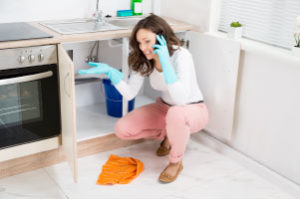Plumbing problems usually happen without warning, and often at the worst possible time. Not that there’s ever a good time for a problem to occur, but some are definitely worse than others.
What can you do to cut back on plumbing problems and catch others at the earliest possible stages of development? Here are several useful home DIY tips:

Clean behind your fridge
What does cleaning behind your fridge have to do with your plumbing? Plenty, assuming you have one that makes ice by itself and produces cold water on demand. And that’s reason to at least look behind your refrigerator once a month or so to inspect for signs of water on the floor or baseboard. If you do spot water, chances are there’s a leak where the water line from your kitchen faucet connects with your water and ice maker. The sooner you get that fixed, the better.
Don’t ignore low water pressure
If water pressure is low at just one faucet, chances are you have an isolated problem. But if you’re experiencing low water pressure at multiple water sources, you should investigate the cause. It could be something as simple as the water department doing routine repair or maintenance work…one phone call can solve that little mystery. Low water pressure also can be caused by internal pipe corrosion. If that’s the case, it’s better to incur a repair bill than wait until your pipes have to be replaced.
Remove hair from sink and tub drains
If anyone in your family has long hair, you have clogged drain problems waiting to happen. To prevent them, clear out the stoppers in your shower, tub, or wherever else hair is washed at least once a week. In addition, use an organic drain cleaning compound like Bio-Clean to help keep your drain lines open while and hair-free. Bio-Clean is not available in retail stores, but you can obtain a supply by calling Eagle Service Company.
Keep an eye on your hot water
The older your water heater, the more important it is to keep a close watch on your hot water supply. If, for example, it appears to be brown or rust-colored, that’s a clear indication of internal storage tank corrosion and means your water heater most likely must be replaced.
Here’s another great way to prevent plumbing problems in the first place or, at the very least, spot them in the early stages of development: start scheduling annual whole-house plumbing inspections. That’s a signature service of ours here at Eagle Service Company precisely because our inspections lead to lower repair costs and longer-lasting plumbing. If it’s been a year or longer since your last whole-house plumbing inspection, why not contact us to schedule service today.


